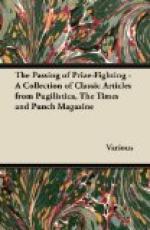My idea is to take some weekly magazine which caters either for some special trade or amusement or pursuit. Let us imagine it to be The Chicken Run, with which is incorporated The Fowls’ Guardian. I am entitled to assume that most of Mr. Punch’s readers are acquainted with this bright and lively feathered journal. My plan is to get together some bold spirits, to capture the editor and his staff, and to hold them in a comfortable but rigorous imprisonment for one week; to take possession of the editorial office, and then to set to work to transform the contents of the paper. I foresee the amazement of the faithful readers of The Chicken Run, on being informed, in the column headed “Hints to Beginners,” that Mr. LLOYD GEORGE’S pet Leghorn cockerel has developed a surprising taste for latchkeys, and recently swallowed two of them, while Mr. ASQUITH’S Buff Orpington pullet has taken to following him about like a dog and roosting on his bed-rail. Then there would be a breezy editorial article designed to prove that poultry had come out of the war with a much enhanced reputation, owing to the loyal part they had played in assisting the FOOD-CONTROLLER.
Further, there would be special articles proving, for instance, that champagne is the one drink on which all breeds of chickens increase and multiply their production of eggs, especially if hot caviare is afterwards administered in large bowls. Then there would be the first chapters of an enthralling serial whose plot revolved round the love-story of Sir Robert Wyandotte and Lady Cecilia Buttercup—a literary effort of unparalleled brilliancy due to the genius of a new novelist who preferred to be known as the Red Rover of Rhode Island. And so on and so on. If you think the scheme is feasible, let me hear from you and I will begin to get my team of villains together.
Yours faithfully,
THE GAME CHICK.
* * * * *
“Women and young persons
now employed in these works enjoy a miximum
working week of fifty-five
and a half hours.”—Sunday Paper.
And, we suppose, a manimum wage.
* * * * *
AT THE PLAY.
“THE BABES IN THE WOOD.”
When I saw a dull red glow in the early evening sky above the great open flares that lit the portals of the Theatre Royal, I said to myself, “This brings the Peace home to one!” But those who think that England will never be the same after the War, that all things will become new and better, have not reckoned with the Drury Lane Pantomime. Its tactics may change, but its general strategy remains untouched by War or Peace. Under any name—Ali Baba or Aladdin, Puss in Boots or The Babes in the Wood—its savour is the same. If only a tenth part of the enterprise that goes to the making of its great pageants were devoted to the invention of a new subject, though it were only The Babes in Boots or Puss in the Wood! However, with Bolshevism in the air it is best perhaps not to tamper with British institutions.




